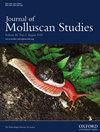一种被遗忘的陆地蜗牛亚种,来自西阿尔卑斯山的一个更新世避难所
IF 1.2
4区 生物学
Q2 MARINE & FRESHWATER BIOLOGY
引用次数: 0
摘要
来自意大利Biellese阿尔卑斯山脉的高山Arianta种群的特征是无孔,薄壳,深棕色外壳,没有或有稀疏的亮点,类似于在缺钙地区发现的Arianta arbustorum arbustorum的广泛表型。因此,它们不被认为是一个独特的分类单元。然而,分子系统发育分析表明它们属于来自西阿尔卑斯山和比利牛斯山脉的a . arbustorum亚种群。我们将它们归类为一个独特的亚种,即Arianta a. doriae (Paulucci, 1878),这减少了arbustorum西部亚种群与Arianta起源的东阿尔卑斯山之间的地理差距。这个亚种在比耶利斯阿尔卑斯山脉南缘的外围山区避难所的冰河时期幸存下来。本文章由计算机程序翻译,如有差异,请以英文原文为准。
A forgotten subspecies of the land snail species Arianta arbustorum from a Pleistocene refuge in the Western Alps
Alpine Arianta populations from the Biellese Alps in Italy are characterized by imperforate, thin-shelled, dark brown shells without or with sparse light spots that resemble widespread phenotypes of Arianta arbustorum arbustorum found in calcium-deficient areas. Therefore, they were not considered a distinct taxon. However, molecular phylogenetic analyses show that they belong to a group of subspecies of A. arbustorum from the Western Alps and the Pyrenees. We classify them as a distinct subspecies, Arianta a. doriae (Paulucci, 1878), which reduces the geographical gap between the western group of subspecies of A. arbustorum and the Eastern Alps where Arianta originated. This subspecies survived the glacials in a peripheral mountain refuge at the southern margin of the Biellese Alps.
求助全文
通过发布文献求助,成功后即可免费获取论文全文。
去求助
来源期刊

Journal of Molluscan Studies
生物-动物学
CiteScore
3.00
自引率
8.30%
发文量
36
审稿时长
3 months
期刊介绍:
The Journal of Molluscan Studies accepts papers on all aspects of the study of molluscs. These include systematics, molecular genetics, palaeontology, ecology, evolution, and physiology. Where the topic is in a specialized field (e.g. parasitology, neurobiology, biochemistry, molecular biology), submissions will still be accepted as long as the mollusc is the principal focus of the study, and not incidental or simply a convenient experimental animal. Papers with a focus on fisheries biology, aquaculture, and control of molluscan pests will be accepted only if they include significant advances in molluscan biology. While systematic papers are encouraged, descriptions of single new taxa will only be considered if they include some ‘added value’, for example in the form of new information on anatomy or distribution, or if they are presented in the context of a systematic revision or phylogenetic analysis of the group.
 求助内容:
求助内容: 应助结果提醒方式:
应助结果提醒方式:


